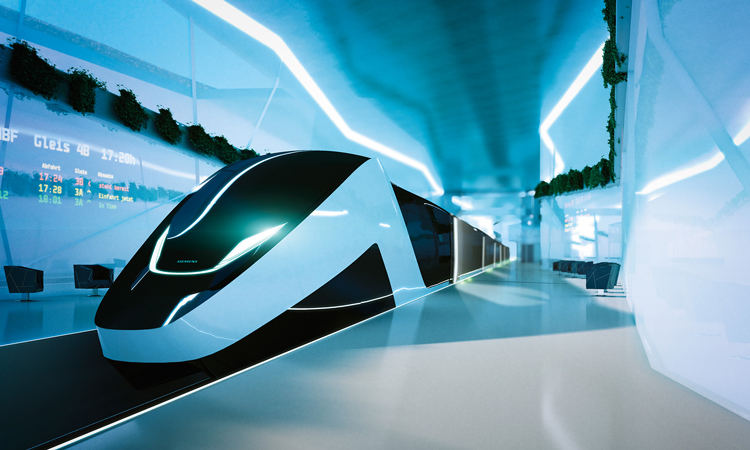Developing the rolling stock of the future
Posted: 19 October 2015 | Eulalia Peris - Roll2Rail, Javier Goikoetxea - Roll2Rail | No comments yet
A modal shift to rail is crucial in achieving a reduction in greenhouse gas emissions, relieving urban congestion and providing increased mobility. In order to successfully meet this growing demand for efficient and green mobility, the railway sector needs to progress in terms of quality of service, energy and life cycle costs, interoperability, capacity, noise reduction and must also further develop its carbon emission advantages. Roll2Rail – one of the so-called ‘lighthouse projects’ of Shift2Rail – will tackle these challenges in order to advance towards the rolling stock of the future. Eulalia Peris and Javier Goikoetxea, Roll2Rail Project Coordinator and Technical Leader respectively, explain further.


The European Union has committed to supporting the railway sector by investing in research that endeavours to revolutionise current railway technologies in order to boost the use of rail transport and drive the competitiveness of the rail sector versus other means of transport. To this end, in 2014, the EU officially launched the Shift2Rail public private partnership which focuses on building the railway system of tomorrow. Shift2Rail is the first European initiative to deliver focused, market-driven research by accelerating the integration of new advanced technologies into innovative rail products, meeting the key objectives of the EU 2020 Strategy and the EU Transport policy.
While the start of Shift2Rail research activities in 2016 is moving ever closer, Roll2Rail is setting the foundations for many of the technologies that will be continued within Shift2Rail’s Innovation Programme 1: ‘Cost-efficient and reliable trains, including high capacity trains and high-speed trains’. It is planned that Roll2Rail will transition into Shift2Rail when the joint undertaking is fully operational in 2016. The start of this preliminary work on the future core research activities of Shift2Rail is a major milestone for the European rail industry, which is currently facing strong competition from outside Europe. It could be said that the start of Roll2Rail, as well as that of the other Shift2Rail lighthouse projects, represents the actual beginning of the research and innovation work of Shift2Rail.
Roll2Rail, or, to give its full title, ‘New Dependable Rolling Stock for a more Sustainable, Intelligent and Comfortable Rail Transport in Europe’, aims to develop key technologies that will overcome hurdles to innovation in rolling stock development and forms part of a longer-term strategy towards revolutionising the rolling stock of today. In keeping with the long-term goals of Shift2Rail, this project envisions paving the way towards a 15% increase in the capacity of the railway system, a 50% increase in the operational reliability and punctuality of the vehicles, a 30% improvement in energy efficiency of the system, and a 40% reduction in vehicle and track life cycle costs, while at the same time also improving passenger comfort.
Roll2Rail was officially launched in May 2015 after being selected by the European Commission following the first ‘Mobility for Growth’ call of the Horizon 2020 Programme. With a budget of €16 million, the project involves 31 partners covering a wide range of expertise in different areas. Together, UNIFE, and the technical leader, the Spanish train manufacturer CAF, are coordinating a consortium comprised of train manufacturers, infrastructure managers, railway operators as well as research centres and universities based in different EU countries. This variety of key stakeholders is essential in order to ensure the successful adoption of results leading to the step change required in the rail industry. As aforementioned, Roll2Rail will transition into Innovation Programme 1 of Shift2Rail meaning that at the end of the project the outcomes will be incorporated into real vehicles or relevant environments. Thus, the railway sector is placing high expectations on the results of Roll2Rail since they must provide a basis for future work enabling European railway innovation.
Roll2Rail is an ambitious research project which focuses on technological innovations in different subsystems of the vehicles which, individually, each and all together, contribute to achieve the desired impact at vehicle and whole railway system level on capacity, reliability, efficiency, comfort and life cycle costs. The project expects innovations in eight different areas such as traction and power electronics, train communications, car bodyshell, running gear technologies, brakes, train interiors, noise and vibration and energy performance – each of which has a dedicated work package (WP). The specific challenges and expected outcomes for each Work Package are:
WP1
Investigating more energy efficient, better performing, lighter, quieter and less bulky traction systems; the objective of this WP is to propose a new traction technology based on emerging electronic components and motor-wheel high-speed equipment.
WP2
Looking into a new generation of train communication systems; in particular, this WP will develop new wireless technologies applied to train control functionalities.
WP3
Working on the reduction of vehicle weight by investigating car body solutions based on lightweight composite materials.
WP4
Focusing on innovation in the field of running gear; in particular, this WP aims at quantifying the life cycle cost impact of existing and new running gear technologies.
WP5
Aims to break down barriers for innovation in brakes by investigating and proposing future requirements for the process of homologation and harmonisation of brakes.
WP6
Working on attractive and innovative environments for passengers; the aim of this WP is to develop standardised methodologies for assessing attractiveness and comfort from the passengers’ point-of-view.
WP7
Researching the implementation of novel and more efficient noise mitigation measures, specifically regarding the development of methodologies for noise source separation techniques.
WP8
Looking into the quantification of energy baselines by developing an energy calculation methodology.
The project has just started and there are still more than two years of work ahead before the finalisation of Roll2Rail. There are many challenges to tackle and big questions to be answered along the way, but the project partners are confident in a successful and significant final result. Roll2Rail is offering the European rail sector the opportunity to make pioneering railway rolling stock here in Europe and abroad, as well as the chance to contribute to ground-breaking railway technologies and the ability to contribute to the design of rolling stock that meets the needs and expectations of future customers. Since 2011, the railway community has been dreaming of the next generation of trains. Today this dream is becoming reality as Roll2Rail begins its research.
References
Biographies












